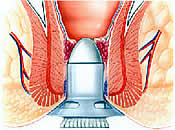PPH Hemorrhoidectomy, Stapled Hemorrhoidectomy
This is the first revolution in hemorrhoidectomy in 50 years. Hemorrhoids are a common condition. We are all born with hemorrhoids but some of us will suffer from them occasionally. The main complaints are bleeding and protrusion (prolapse). This may lead to pain but usually hemorrhoids are painless.
Surgery is indicated for advanced cases (3rd and 4th degree – for a classification of hemorrhoids please refer to Hemorrhoids). Hemorrhoid surgery (hemorrhoidectomy) is painful. The reason for pain is that during surgery, the hemorrhoids are cut off the anus. These wounds hurt. Most patients stay in hospital overnight and sometimes they will take up to 2 weeks off work.
For many years, surgeons have tried everything to make hemorrhoidectomy less painful. Patients have tried everything to avoid surgery. They prefer to suffer from hemorrhoids in silence.
As we age the anal tissue becomes loose and may slide out when we have a bowel movement. This sliding of tissue is called prolapse. Straining at a BM increases this prolapse and straining damages this tissue. This damage causes bleeding.
PPH stands for “Procedure for Prolapse and Hemorrhoids.” With the new PPH or stapled hemorrhoidectomy there is no need to cut out the hemorrhoid tissue at the anus. Instead, this procedure removes the loose tissue above the anus – this is like an “anal facelift.” The area above the anus does not have the same nerve endings as outside the anus. The patient will not feel the sharp pain of conventional hemorrhoidectomy. Since the nerve endings are different, the patient may feel a dull but tolerable ache for a few days.
The preparation for surgery is the same as for conventional hemorrhoidectomy. No special bowel prep is needed. The patient eats a normal diet the day before surgery. No food or water is allowed after midnight before surgery. A Fleet enema is used at night before going to bed and again an hour before leaving for the hospital. Antibiotics are not routinely used.
Stapled hemorrhoidectomy can be done under local anesthesia with sedation, general anesthesia or spinal/epidural anesthesia. The patient is placed in the prone position – lying on pillows on the OR table. A special hemorrhoid stapler is used to remove the excess loose tissue above the anus. (housecalldoctor.com.au) This stapler cuts off the tissue and sutures (or staples) the remaining tissue edges together. These are special microscopic titanium staples. These staples will fall off over the next few months. The patient will not be aware of these staples. There is no sharp pain as there are no anal wounds. External hemorrhoids are usually left alone and these shrink over the next 2 months as the stapling procedure interrupts the blood supply to these hemorrhoids.
The patient can go home on the same day or stay overnight if desired. He/she is able to go to work within 2 to 4 days. Painkillers are prescribed.
The complication rate is similar to that of conventional hemorrhoidectomy. Significant bleeding occurs in only about 2%. Wound infection is rare. Fecal incontinence is rare. Narrowing of the anus (stricture) occurs in 9% but this is easily and painlessly treated with finger dilatation in the office. The risk of external hemorrhoids persisting after surgery is similar to conventional hemorrhoidectomy.
One center (Cheetham. Lancet 2000;356:730) reported that 31% in their small series of 22 patients developed severe pain for up to 15 months. This is the only report of severe pain with this new surgery. Most centers with large numbers of patients in Italy, Germany and Singapore have not seen this complication.
Over 210,000 stapled hemorrhoidectomies have been performed worldwide. In some hospitals this is the preferred surgery for hemorrhoids.
In 2001 Dr. Khoo was fortunate to study with Professor Thorolf Hager in Kronach, Germany. Dr. Hager is an internationally renowned colon and rectal surgeon. Dr. Khoo has performed 100 stapled hemorrhoidectomies and when he was in Colorado, he trained over 3 dozen U.S. surgeons to perform this surgery. Two years ago he broadcast this procedure live to the American College of Surgeons meeting in New Orleans. He is presently training surgeons in the North Bay in this procedure.
U.S. surgeons need to be skeptical about accepting any new procedure. More study may be necessary. However many randomized trials have been published demonstrating the safety and high satisfaction with stapled hemorrhoidectomy.

This picture is a cross section of the anus and lower rectum. It shows the loose tissue above the hemorrhoids and this loss of support allows the hemorrhoids to prolapse out.

A dilator is placed inside the anus which pushes the hemorrhoids and the loose tissue back inside.

Through a special anoscope which holds the anus open, I place a suture which grabs the loose rectal mucosa above the hemorrhoids. I will use this purse-string to draw the loose rectal tissue into the stapler.


















